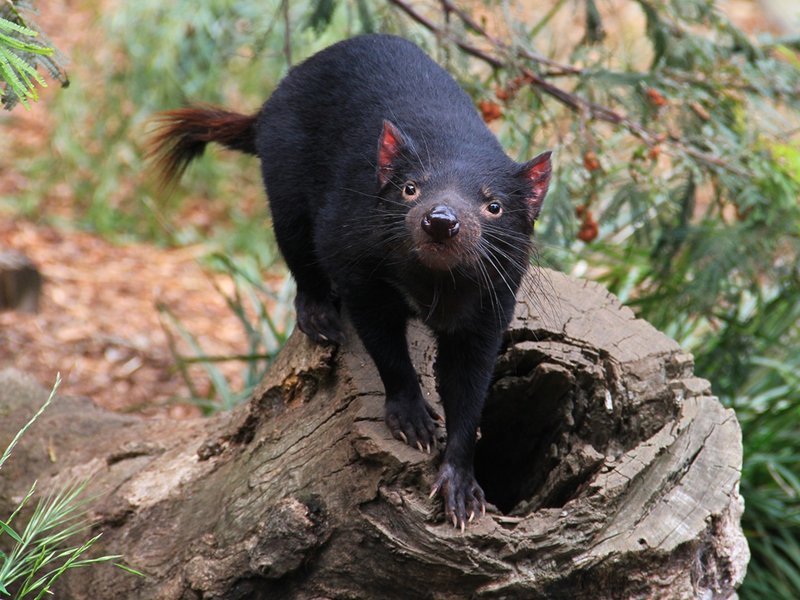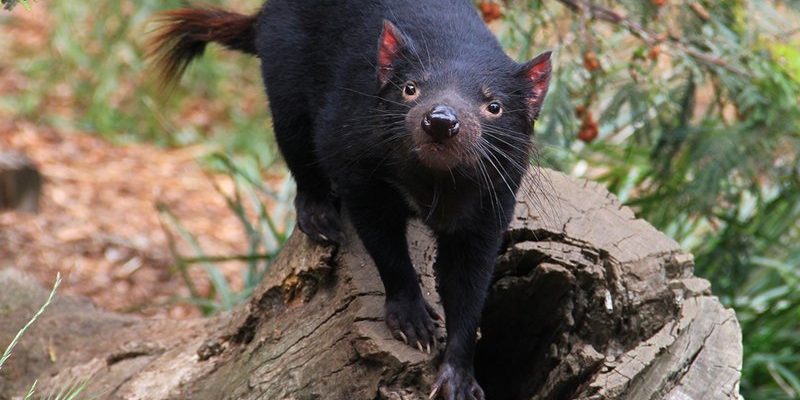
Living mainly in Tasmania, these animals have a tough reputation due to their fierce behavior and distinctive growls. But there’s much more to them than just noise and attitude. So, let’s dive in and explore ten fascinating facts about the Tasmanian devil that might just change the way you see these fascinating creatures.
1. A Unique Marsupial
Let’s start with the basics. The Tasmanian devil is a marsupial, which means like kangaroos and koalas, they carry their babies in a pouch. But unlike these more cuddly creatures, the Tasmanian devil has a reputation for being a bit more rugged. These guys weigh about 20 to 30 pounds and are about the size of a small dog. This stocky build helps them pack a punch when it comes to foraging for food.
You might be wondering how they fit into the broader category of marsupials. Well, they belong to the Dasyuridae family, which also includes quolls and the extinct thylacine, or Tasmanian tiger. So, the Tasmanian devil is not just an outlier but part of a fascinating lineage of unique Australian wildlife.
2. Not Just a Cartoon Character
While many of us grew up with the jovial antics of the Looney Tunes’ Tasmanian Devil, the real-life version is quite different. This creature has a personality that’s more complex than a cartoon character could convey. They are known for their fierce temper and loud, screeching calls, which can sound quite menacing.
However, much of this behavior is simply a means of survival. The real Tasmanian devil is nocturnal and relies on its sound to communicate with other devils while hunting for food at night. It’s like they have their own special language, which only adds to their fascinating persona.
3. They Have a Remarkable Sense of Smell
Imagine the ability to sniff out food from miles away. Well, the Tasmanian devil has an incredible sense of smell that helps it find carcasses in the wild. This ability is vital since they primarily scavenge rather than hunt live prey. In fact, they are known as carnivorous scavengers, meaning they often dine on already dead animals.
This impressive olfactory tool means they can locate food even days after the animal has died. It’s as if they have a built-in radar for dinner! Because of their scavenging habits, they help keep the environment clean by consuming carcasses that might otherwise spread disease.
4. They Have Powerful Jaws
Here’s a fun fact: the Tasmanian devil has one of the strongest bites relative to body size in the animal kingdom! Their jaws can exert a massive amount of force, allowing them to crush bones with ease. The bite strength is about 1,000 PSI (pounds per square inch), which is impressive considering their small size.
This strong bite helps them break down tough food items like bones, which is crucial during their scavenging adventures. Think of it like having a built-in tool for dealing with dinner, no utensils needed!
5. They’re Threatened by Disease
Despite their feisty nature, Tasmanian devils face serious threats to their survival. A contagious cancer called Devil Facial Tumor Disease (DFTD) has devastated their population. This disease causes large tumors to grow on their faces and necks, making it difficult for them to eat.
This disease has been so impactful that it’s led to the decline of the Tasmanian devil population by around 80% since it was first discovered in the 1990s. Conservation efforts are currently underway, with breeding programs in captivity to save these unique animals from extinction.
6. They Play a Crucial Role in Their Ecosystem
Tasmanian devils aren’t just fascinating to study; they also play a crucial role in their ecosystem. By feeding on dead animals, they help control the spread of disease and contribute to the overall health of their environment. Think of them as nature’s clean-up crew!
When they consume carcasses, they help return nutrients to the soil, benefiting other plants and animals in their habitat. Their scavenging behavior promotes a balanced ecosystem, showing just how interconnected the web of life can be.
7. They Have Unique Social Structures
These little devils are not solitary creatures; they often gather in groups, especially when feeding. This social behavior can be quite entertaining to observe. When they come together for a meal, it’s like a bustling dinner party where everyone is eager to get their share, complete with vocal sparring.
The social hierarchy among Tasmanian devils can be complex. Dominance can shift based on strength, size, and personality. Watching them interact is a reminder of how social structures exist even among seemingly simple animals.
8. Their Breeding Behavior is Intriguing
Breeding season for Tasmanian devils occurs in late summer, and females typically have up to four babies. But here’s the catch: they only have four nipples, meaning not all babies can be fed if more than four are born. This leads to some fierce competition among the little ones, and sadly, only the strongest pups usually survive.
This natural selection process ensures that only the most fit offspring continue the species. It’s a tough world out there, but it’s also a fascinating one, showing the lengths animals will go to adapt and thrive.
9. They Can Live Up to 5 Years in the Wild
In the wild, the average lifespan of a Tasmanian devil is about 5 years, although some can live longer in captivity. Their harsh living conditions, competition for food, and threats like road accidents contribute to their shorter life expectancy.
In captivity, their lifespan can extend significantly, sometimes reaching up to 10 years or more. This gives researchers a unique chance to study their behavior and biology, helping with conservation efforts.
10. They’re Cuddly But Ferocious
Despite their spunky personality and fearsome reputation, many people find Tasmanian devils adorable. With their small ears and cute faces, they certainly have a cuddly look about them. But don’t let that fool you! When threatened, they can become incredibly vocal and aggressive.
This fiery nature is part of what makes them so intriguing. They are a reminder that nature can be both charming and fierce at the same time, showcasing the beauty of diversity in the animal kingdom.
In conclusion, the Tasmanian devil is a remarkable creature that deserves our attention and protection. From their unique behaviors and social structures to the challenges they face in the wild, there’s so much to learn about them. So, the next time you hear about Tasmanian devils, remember—they’re not just cartoon characters; they’re vital pieces of our ecosystem worthy of respect and conservation efforts. Let’s celebrate these fascinating animals and work together to ensure they thrive for generations to come!

